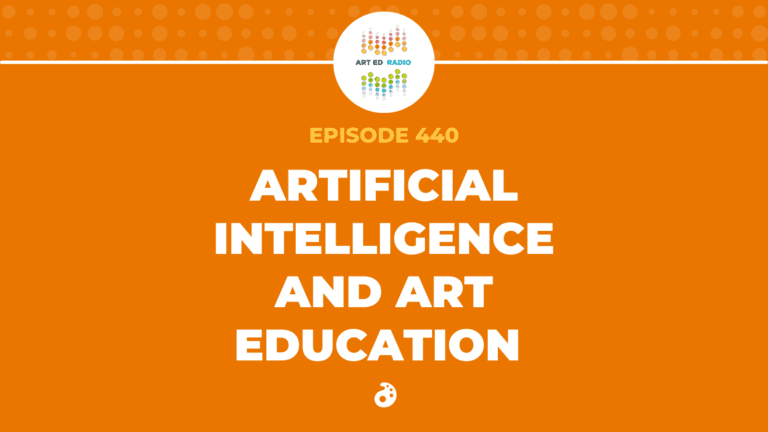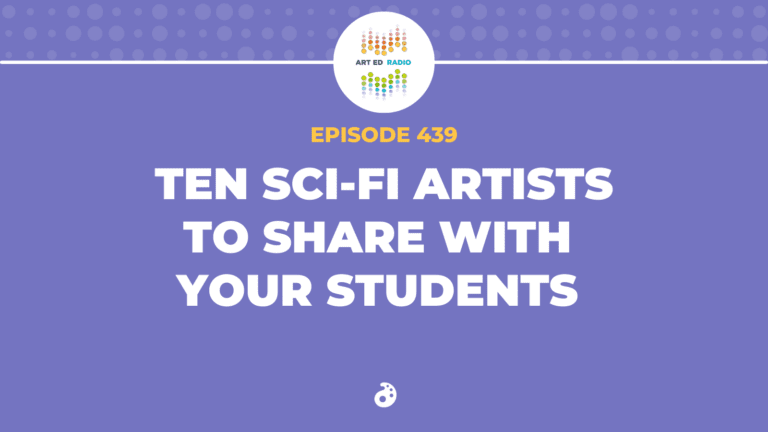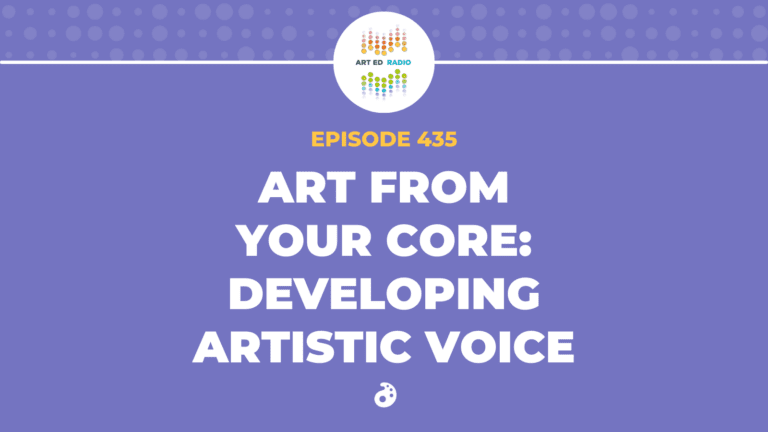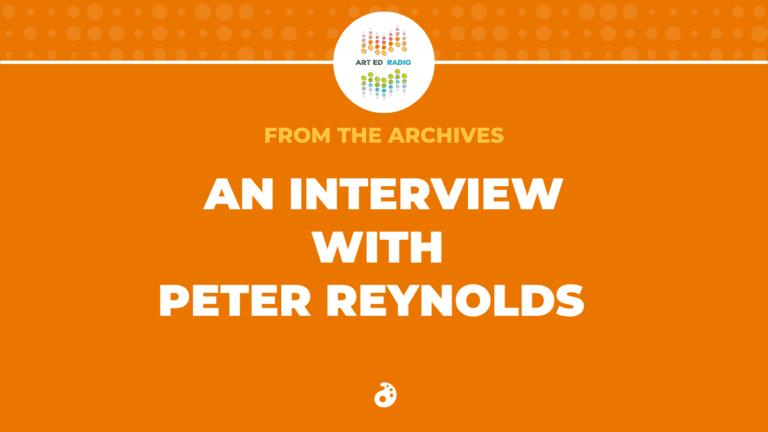Ahead of the 2024 Winter NOW Conference (which is now just 3 weeks away!), presenter Meera Ramanathan comes back to the podcast to preview her upcoming presentation on collaboration. She talks with Tim about the benefits students get from collaboration, how we can get even our youngest students involved in collaborative projects, and what it’s like for her students to have the opportunity to work with a visiting artist. She also shares ideas on how the community can be involved in these projects and how schoolwide projects can bring excitement to your campus.
Full episode transcript below.
Resources and Links
- Find Meera on Instagram
- See the work of artist Michelle Montjoy
- The Lessons We Learn From Collaboration
- The Case for More Collaboration
- Check out the NOW Conference!
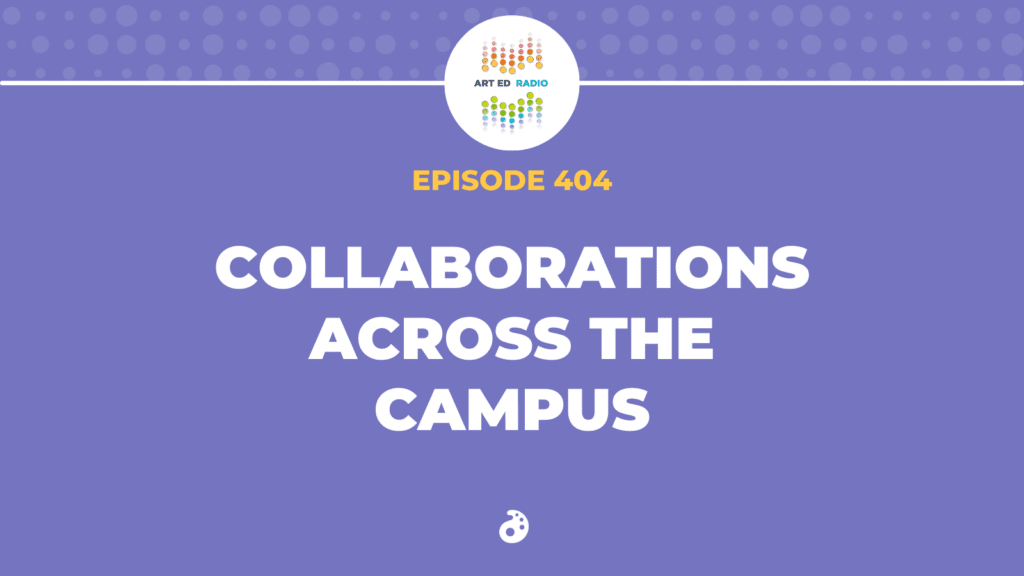
Transcript
Tim:
Welcome to Art Ed Radio, the podcast for art teachers. This show is produced by the Art of Education University, and I’m your host, Tim Bogatz.
We are now just about 3 weeks away from the Winter NOW Conference, and I want to take an opportunity over the next couple of weeks to preview some interesting presentations and talk to some interesting presenters. Today’s guest will be Meera Ramanathan. Meera is an art teacher from San Diego, and she presented at the last NOW Conference over the summer, leading an artmaking session on Kolam Art, and she also gave a presentation on podcasting with her students that also proved to be incredibly popular. She will be back at the Winter Conference this time talking about all of the collaborative projects she does with her students in a presentation called collaboration across the campus.
I love seeing all of the ideas she has for collaboration–sometimes they are classwide projects, sometimes they are schoolwide projects, but she has so many great ideas and has facilitated so many wonderful projects. If you are looking for some ideas for collaboration, or for public art, or for schoolwide projects, you will not want to miss her presentation.
But Meera is here, and I’m so excited to welcome her back to the show. Let me bring her on now.
All right. And Meera is joining me now. Meera, how are you?
Meera:
I’m doing great, Tim. How are you?
Tim:
I am also great. I’m very excited for people to learn more about your presentation. Thrilled to have you back at the NOW Conference. Thrilled to have you back on the show. Can you just tell how have things been going for you? Has the new semester started well for you?
Meera:
Yes, it’s been really good. So, the kids are excited to be back. I was excited to go back because there’s so many things you do over the summer and it’s a nice rejuvenation, you feel refreshed going back. So, I was really excited to be back in the classroom. The kids were excited to come back because art is something they’re always looking forward to because ours is a fine arts academy with a heavy emphasis on visual art. We started the year with a really nice event for the families and the students. It’s called Arts Around the World, where the art teachers, admin, and the classroom teachers, we come together and we have a whole evening of art making, which is always a huge hit. The families like it. There are food trucks, and of course, art from different parts of the world. So, it’s been great so far.
Tim:
Yeah, that sounds amazing. I love that. Now, I guess the reason we have here is to talk about your presentation from the NOW Conference that’s going to be coming up in just a couple of weeks here. I talked about it a little bit in the intro, but obviously, you can explain things better than I can. Can you give us a quick overview of just what your presentation is going to be about what people can expect at the NOW Conference?
Meera:
Absolutely. So, my presentation is titled Collaborations Across the Campus. Now, I teach in an elementary school. I teach students four to 11 years old. And what I’ll be talking about are the different collaborative projects that I’ve created with students that are installed in different parts of the campus. I talk about what every project is, a brief introduction about how I went about creating the project with the different students, what the project entails, how many students were involved. Because sometimes when I also look at the different projects that different teachers have created, it’s just nice to get a complete picture about how many students were involved, what are some of the challenges that I faced and where it is installed. Because collaborative projects sometimes can be really huge, and it’s like where do we install those? So, it just talks about the different projects that I’ve created over the past couple years with the different grades in my school.
Tim:
Yeah, that’s really cool. And what I love about it too is just there is a plethora of projects, that you’ve done so many cool collaborative things and your presentation just keeps going and going with more and more ideas, and I love it. There’s so many very exciting, very cool things that you’ve done, and so I think that’s cool. You mentioned you teach pre-kindergarten, four and five-year-olds, and I’m very curious about how you’re able to get that age to collaborate. So, I guess the question for you is how are you able to design projects for students that young to do some collaborative stuff? What types of projects are they able to do? What kinds of things have you been able to put together for those younger students?
Meera:
Absolutely. I was a preschool teacher for nine years before I started teaching art. So, I do love my littles. I love the four-year-olds. What I always do with the younger grades is wait to do the collaborative projects. I usually wait so that they’ve had a lot of practice and experience being in the art classroom, and I’m able to just see what they enjoy doing, and I then decide what the collaborative project is going to be. So, I usually wait maybe until spring till I decide and I plan what kind of art project to do with them. So, in the past with kinders, I’ve done a project where we’ve drawn and cut different shapes and they’re able to cut it and they’re able to add different kinds of textures with it. And what’s nice about collaborative projects with the younger grades is keeping it really simple, making it open-ended and giving them a lot of choice. I think the younger grades really love that.
And what also helps is when you wait until the spring to do the collaborative project, you are able to judge how you want the tables to be like, what kids do you want to group together. And there’s always one or two at every table that are able to help each other, help the other kids and collaborate. So, I think knowing that… And that’s the reason I wait, because by then, you’re really able to tell how you can group the kids together so that they’re able to help each other.
And with the first grades, I’ve done weaving where we’ve used long strips of yarn and I’ve had plastic fences at every table. And there is always one that knows how to maybe tie the knot, and it’s like, “Well, can you help the others?” And of course, you’re moving table to table, but always having one or two students that get it and are able to help the other kids. And I think that’s the beauty of collaboration where you’re able to have the students work together. They’re constantly learning from each other, asking those questions while you are moving from table to table. So, keeping it simple, open-ended, and waiting for a couple months before you embark on the collaborative project really helps.
Tim:
Okay. Yeah, that’s really good advice. I was just very curious about that. And I know you talk about waiting, but I also know that you like to start the year with some collaborative stuff, and I think a lot of teachers really like beginning of the year collaborative projects. Can you talk about, if you’re starting off the year with that, how are those projects done? How is that put together and what kind of benefits do you see from starting the school year with a big either class-wide or even school-wide collaborative project?
Meera:
Yeah. So, I create the beginning of the year collaborative project during the first week of school. And I typically do this with grades two to five. So, it’s about 22, 23 classes that come into my room. I keep it pretty simple and quick. It’s about 45 minutes per class just because I want to make sure that all of these classes are able to come and they’re successfully able to create this. Everybody in the school knows that we start the year off like this, and they’ve come to expect it on that Friday of the first week, that’s when it’s held in the school auditorium. And it just stays for the rest of the school year until we take it down for Celebration of Art, which is my school’s big art show. So, this has come to be expected from the entire school community.
So, what I do is I look for an artist inspiration. I’ve used different artists in the past. But there are certain artists who lend really well to this kind of collaborative art projects. We all start with a six-inch construction paper square, and we add things to it. So, I’ve have had ceramic artists as inspiration in the past that lend themselves really well to this. So, when the students come in, we do a quick introduction, we have a class discussion about what they see, and then we start working on the project. So, it’s just a six-inch square that the students add to. And once they’re done, I give them a large 18 by 24 inch construction paper, and they have the complete flexibility and the freedom to glue it in any direction that they want because it’s a square, then it fits really well, and we keep adding to it.
So, every class that comes, gets to see what the previous class has done. So, they see the continuity of how it all happens. And I usually change the colors just so that every class gets a different color combination of what they’re working with. So, when I finally put together, they see that transition from where they’ve started and how it goes from the left to right. Once I have these 18 by 24 inch construction papers, I put them together so that when I put it in the auditorium, in the stage, it’s really pretty simple. I just put those T-pins to make them stay. I’ve tried using staples in the past, but it keeps falling. So, use the T-pins because the paper gets heavy.
Tim:
I was going to say, it gets heavy when you have hundreds upon hundreds of things hanging there.
Meera:
Yes, I’ve learned through trial and error that this works the best. And the kids love it. I think it’s just such a nice way to start the school year. The teachers sometimes bring their kids to see it, and since it’s always there in the auditorium, students will look at it during lunchtime when they go to get lunch, and there is just a lot of conversation that happens. I overhear them talking. I usually go there and wait during lunch, so I can hear some of the conversation. And they’re always looking at it going, “Wow, that’s what I did. That’s what you did. We had this color combination.” It just generates so much great conversation. And of course, it builds a sense of community. Students get a sense of pride, because each one of them has contributed into something that is so big. So, yeah, it just brings the school community together.
Tim:
Yeah, that’s amazing. And it’s a great advocacy piece, especially when there’s a reputation for that happening every year, something for kids to look forward to. You really feel like you’re contributing a lot to the school environment and the school community. I think that’s a really, really cool thing. So, kudos to you for doing that and for all the teachers listening to that who are creating those big collaborative projects for their school. Good on you. I think that’s an amazing thing that you can do for your school.
So, one thing that I wanted to ask you about, Meera, you talked about the beginning of your projects doing a lot of drawing, everybody’s got their little square. But I noticed in your presentation a lot of the projects that you do incorporate weaving a lot with yarn. I think you had one with old T-shirts that you were talking about that create some really, really cool things. So, I guess I would love for you to just talk about that and just tell us a little bit about the benefits to doing weaving with your students, and just how that medium [inaudible 00:10:44] can lend themselves to big collaborative projects.
Meera:
Sure. So, I’m attracted to yarn just because I specialized in textile design when I was doing my master’s back in India. So, I’m just attracted to yarn. I think it’s got that tactile aspect to it. It’s just something soft. And when I first started working at Zamorano, I tried it out. I tested a weaving project with students and I was just amazed at how well it was received. I think students just love the yarn. Like I said, the tactile aspect, having yarn in different textures, the different thicknesses, the different colors. So, I do do a weaving project. I try to do it with second grade first, actually even first grade. That’s what I started last year with. I differentiate the weaving projects. I think it’s a great way for students to develop their fine motor skills. Kids love the yarn, the different colors, the thicknesses, the texture.
And the one thing that really works with them is that it’s repetitive. And even those students that are really not very confident about trying out new projects, they love the repetitive aspect of it, because once it clicks, you’ve got it and then you’re just going, going, going. And it just gives students so much confidence in doing it. So, I think weaving is just great. There’s so much you can do with it. With the lower grades, I use thicker yarn just because they’re able to hold it and weave larger openings just so that they can go over and under more confidently. And as we progress towards the older grades, I use thinner yarn. I’ve used bicycle reeds from Dollar Tree, and students have woven in circles going over and under. Third grade does a lot of weaving with paper, and they develop their own motifs and they add to it.
Fourth and fifth grade, they do weaving on the cardboard looms that I buy from Amazon, and they absolutely love it. And it’s nice to be able to differentiate it with fifth grade. Once they’re done with the weaving, I also give them a needle and yarn to add different areas of interest, or they’re welcome to use contrasting colored yarns to knot and then just let it go so it creates fringes. And it’s interesting you brought up the T-shirt yarn, because we finished that project on Friday. We have a phenomenal artist here in San Diego. Her name is Michelle Monjoy. So, she specializes in this kind of art. And the T-shirt yarn project is one of my favorite because it brings the entire community, the teaching, the parent and the student community together because the parents donate the T-shirts, and they help cut the T-shirt so that we could make yarn out of it.
And then, I’ve had this artist, Michelle Monjoy, come with her looms. In fact, just on Friday, the day before she came to our class, because I received a grant from our new Children’s Museum here in San Diego. So, I was able to get a loom that’s going to stay in my room. And she came with two other looms of students. All fifth grade students were sitting at each loom and they were doing a looping project. It’s a little bit different than weaving, but it’s just a beautiful way to collaborate because they’re just telling each other stories, and we have this T-shirt yarn. And sometimes they even notice the T-shirts that they donated, and it’s like, “Oh, my goodness. That’s the T-shirt that my family donated.” So, it’s just wonderful. They’re just sitting and they’re looping. So, we talk about recycling, about art being sustainable. So, it’s just beautiful. And yeah, weaving I think is the kids love it, which is why I keep doing it.
Tim:
Yeah, that’s awesome. That’s awesome. And I love hearing you describe how kids are working, which leads me into my last question was just all about what students get out of this. Can you just talk about the benefits that the students get from collaborative projects and the benefits they get from working closely with their classmates?
Meera:
Absolutely. I think collaboration teaches them so many soft skills because you’re working together. It’s not just about what you make. You’re looking at the whole picture, what is my art going to look like with other students’ art? So, they’re contributing ideas, they’re learning how to compromise. It’s like there’s a lot of back and forth that’s going, a lot of conversation that’s happening, which teaches students how to make it work. So, that’s number one, practicing their soft skills. And of course, it builds that sense of community. Students, they get so much pride in seeing how their small piece of art is a part of something that’s so much bigger. So, they get a lot of pride in what they’re creating. They’re also organizing information. As a teacher, I’m talking to them about what the collaboration entails, but they’re also getting information from their peers, the person that’s sitting next to them, the person at the table.
So, they’re constantly organizing the information and they’re getting information from multiple sources. So, it really improves their critical-thinking skills. A lot of planning that goes on and sharing the supplies. We have this one bin with supplies, so they’re practicing how to be flexible. They’re learning that it’s not just about them, it’s about the other students at their table. How are you passing the supplies? How are you putting it back? So, even something small like this, they’re practicing how to do that, practicing how to be flexible. And like I said, learning from each other. I think that’s the biggest thing in this. How can we work together? Maybe they’re not understanding what I’m seeing, but when they’re seeing their peer do it, it sometimes just clicks. So, it brings so many cool things together when you’re doing collaborative artwork. And when they see it being hung, installed in the campus, so much pride. So much pride in what they’ve made.
Tim:
Yeah, absolutely. And I think all of those benefits are incredible to think about. And like you said, it’s a great way to develop a lot of those skills. So, I think that just provides a great opportunity for kids. So, I think that’s very cool as well.
Meera:
Absolutely. Absolutely.
Tim:
So, Meera, thank you so much for taking some time to come talk to us. I know everybody’s looking forward to your presentation, and we’ll see you at the NOW Conference in just a couple of weeks here.
Meera:
Absolutely. Thank you so much for this opportunity and thank you for having me on this, Tim. I’m looking forward to the conference.
Tim:
Awesome.
Meera summed up the benefits of collaboration so well there in that last answer! and I would just say that if you are thinking about doing something collaborative with your students, give it a try! Meera provides a great starting point with a lot of ideas here, and you can see a lot more from her at the NOW Conference. I will also link in the show notes to Meera’s Instagram, she has a great post with a lot of pictures from Michelle Montjoy–the visiting artist–and the project that they just finished. I will also link to Michelle Montjoy’s art because there is a lot of really cool stuff there.
And if you are not yet signed up for the NOW Conference, there’s still time! You can find everything you need to register on the AOEU website. We have a great Kickoff on Friday night, February 2nd with games, artmaking, giveaways, and just a lot of fun. Then Saturday, February 3rd, we have Meera and about 15 other presenters with a variety of great topics in art ed, and that includes our featured presenter, subway portrait artist and social media star Devon Rodriguez. You’ve probably seen his stuff on Instagram or TikTok where he is creating portraits of people on the subway. We are so excited to have him and the conversation is a great one. There are also so many more opportunities for learning, as well as access to the After Pass with more presentations, more learning, and more resources that you can access for the next calendar year. I hope that’s enough to convince you that you need to be at the NOW Conference, and if it is, please register at theartofeducation.edu.
Art Ed Radio is produced by the Art of Education University, with audio engineering from Michael Crocker. Thank you for listening, and we will talk to you next week!
Magazine articles and podcasts are opinions of professional education contributors and do not necessarily represent the position of the Art of Education University (AOEU) or its academic offerings. Contributors use terms in the way they are most often talked about in the scope of their educational experiences.
